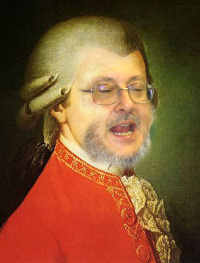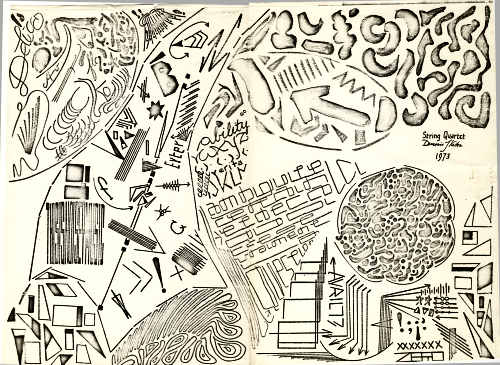A 365-Day Project
"We Are All Mozart"
A project to create
new works and change
the perception of the
music of our time.


 July 6, 2006
July 6, 2006 
These commentaries are slow improvisations. I type and read back, extending the thought zigzaggedly.
Improvisation in all its forms is the largest part of human experience -- which words to say, what nail to strike, which bite to take, how hard to brake, what path to hike, which field to hay. Improvisation sat back in classical nonpop for a few generations, handing over its development to jazz, and only returning in the guise of aleatory during the avant-garde era. But it still blinks in and out of what we do.
Improvising was my musical childhood, as until the teen years there were no music lessons to be had. Music flowed through voices and whistles and taps and bangs. Sometimes there was the need to remember a tune that had caught my interest, and for that I invented a graphical notation -- though calling it graphical notation wouldn't have crossed my young mind, knowing neither word. It worked like this:

Familiar looking? This image above is a recollected reconstruction, but I remember the place and time and tune: at the kitchen counter, age 10, scribbling my code for the theme to the "Our Gang" comedies (can you hear it now?). I loved that tune, but sometimes it would slip away from memory, and I would dig the folded piece of notebook paper out of my pocket and the crayon lines would call forth the shape of the tune so it could be hummed again. Eventually the tune would return unbidden, and that piece of paper disappeared into the trash or the wash.
How did the representation of time and pitch occur to me? I have no idea. Moving from school to school and town to town, there was no opportunity to learn musical code -- not that these scratches were part of it. But the abstraction of pitch and time couldn't have been invented, could it? I had seen piano rolls as a kid. No matter. It opened up the opportunity for shape and direction to be sketched as a kind of stick figure on which to hang the flesh and clothes of sound play. Even as a 10-year-old, I played with sounds and voices and noises and tunes, improvising little acoustic family annoyances.
But it was almost lost to me. When musical notation was decoded for me, it seemed all acoustic phenomena were possible at the wave of a pencil. (Look! These dots and squiggles make a flute play trills!) And a few years later in the university, notation was omnipresent. Performers were not to be trusted to make any but the slightest of expressive judgments. And across the campus, the jazz school was busy having its students transcribe recorded solos and memorize them, right down to the details of technique and sound color.
When aleatory did creep into new music, it was within the highly Europeanized sound whose heritage was Schoenbergian Sprechtstimme, all surprise & bellows & humming without a jolly tune in earshot. Notation expanded and then contracted into cryptic symbols. Cage's Notations appeared, and shortly afterward Erhard Karkoschka's Notation in New Music. Notation, notation, notation. Even the jazz realm of nonpop -- of which I had been an avid follower since accidentally discovering John Coltrane's Ascension in 1964 -- seemed to come with stylized charts:

But what did this mean? It surely meant the end of the Domination of the Dull, that old linear, tonal music-making. Didn't it? My own 1973 String Quartet had challenged those musty traditions by using a color 24- by 36-inch background of source materials with sixteen separate transparent overlays for each instrument and each movement that made up playing pathways. (The original materials are probably lost; all I can find is the faded photocopy below.)

In retrospect, though, how close do these kinds of symbologies come to directed improvisation? What is improvisation anyway, directed or not? And why does it matter to new nonpop?
To answer these questions, one must invoke the definition of nonpop, which was offered some six years ago. According to Wikipedia (though who knows how long the entry will read this way), "Nonpop is a meta-genre comprising the overlapping genres of modern music, avant-garde music, performance art, new music, art music, experimental music, contemporary classical music, and similar genres." As such, the meta-genre includes the contemporary classical repertoire as well as many aspects of jazz, such as the clip of Anthony Braxton's Composition 98 above.
Jazz and the erstwhile avant-garde are nonpop, and both include improvisation as a major component. Jazz is typically directed improvisation, with the direction provided by a chordal structure and a stylistic history, and the result a melodic and contrapuntal development. The avant-garde is directed by notational elements and a different stylistic history, and the result also includes textural development. The latter can be tentative because of the tradition's short history, and confounding because its improvisation is normally intended to be surprising or challenging.
Improvisation is renewal. Notated composition is renewal selected and frozen. Like these commentaries, notated composition extends the thought in zigzags and recursiveness, while real-time improvisation rolls thoughts forward in time by means of imagination and technique in synchronization.
Classical listeners and some composers can't abide jazz and are suspicious of aleatoric -- improvisational -- nonpop. The dislike flows from a confluence of several elements: unlike the comfortable progress of classical music, it is consistently unpredictable, with its clues to motion hidden inside the tradition; it uses a repertoire of unfamiliar licks akin to the familiar repertoire of classical gestures, but with the context being unknown it sounds repetitive; the shape is unspecific at the outset, leaving a sense of time being wasted in getting to its point; and because it takes the risk of composing in real time, it is not always successful, whereas classical music with its zigzags and recursions is always successful. Finally, of course, it uses an instrumentation without the (falsely) assumed subtlety of, say, a string quartet. (In some ways, these same dislikes carry over to minimalism.)
It is for these very reasons that improvisation has a critical presence in new nonpop -- and not just in the old avant-garde aleatoric sense. It is critical to renew the performers' participation and gut-level grip on the styles being created today. It is critical for the composer to understand both possibilities and limits. And it is critical for a creative interaction among musicians to take place. This last is the most important loss during the diminishment of improvising performer to improvising cadenza to composed cadenza to no cadenza, a loss that directed aleatory did not salvage.
Indeed, painful is the best description for the results when classical players attempt to improvise. Despite prodigious technique and powers of analysis, they will fall completely apart due to the paucity of experience and a near-total lack of the inventive resources demanded by on-the-spot composition (or even variation). They will laugh or create ugly sounds or just grab a small lick and repeat it. Absent the tools, symphonic section soloists will fall back on jazz or rock idioms that they might moonlight playing. (My generalization is not meant to disrespect a cadre of particularly younger players who grew up in improvisational pop genres, but this pain remains more a fact of nonpop life than not.)
The cure for this is difficult. Some years ago, I composed a small overture-style piece called Mountain Dawn Fanfare for the Montpelier Chamber Orchestra. They won't be embarrassed if it's revealed that the first runthrough of the score was strained and pained. The music called for solo and sectional improvisation with skeletal pitches. Conductor Catherine Broucek Orr had a tight deadline, and the music wasn't working. You could see the pleading on the musicians' faces: Please just tell us what to do. The musicians were enthusiastic and wanted to play this well, and Maestra Orr looked to me. Together we led the group through the improvisation, suggesting ways in which they could improvise without a fixed placement of notes set out before them. Soloists nodded as they grasped the question and the answer. Section leaders came up with strategies to create thematic variations. In just a few minutes, the group was ready to run with the improvisation. The premiere was luminous -- particularly so with the sense of personal involvement the musicians brought to the creative process.
That is why improvisation is important. All participants share responsibility for telling the music's story. Indeed, the concept of improvisation is the same as telling any story. One recalls the circumstances (or invents them) and begins to string meaning through time by selecting the vocabulary, grammar, structure and shape that reveal the events with the greatest clarity or color or mystery or surprise.
Can you tell the story below?
